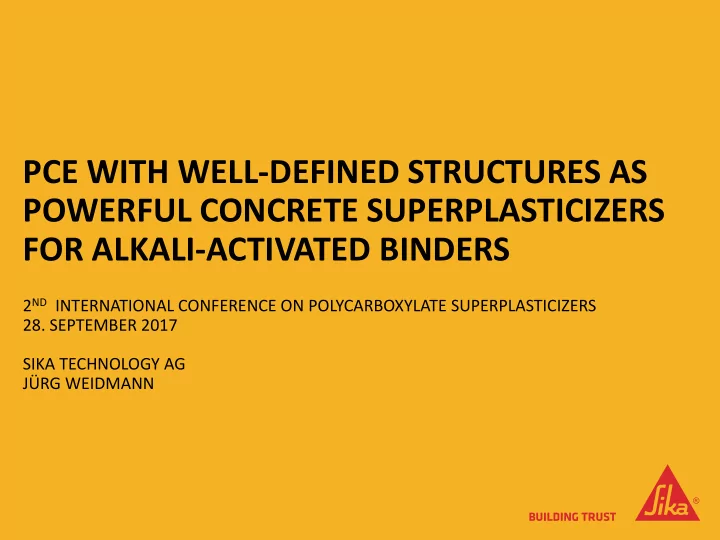

PCE WITH WELL-DEFINED STRUCTURES AS POWERFUL CONCRETE SUPERPLASTICIZERS FOR ALKALI-ACTIVATED BINDERS 2 ND INTERNATIONAL CONFERENCE ON POLYCARBOXYLATE SUPERPLASTICIZERS 28. SEPTEMBER 2017 SIKA TECHNOLOGY AG JÜRG WEIDMANN
TABLE OF CONTENT 1 INTRODUCTION 2 POLYMER SYNTHESIS 3 PCE IN ALKALI ACTIVATED BINDERS 4 SUMMARY 2
INTRODUCTION STRUCTURE side-chain backbone anchor group random distribution of anchor group and side chains 3
INTRODUCTION STRUCTURE MECHANISM steric repulsion side-chain backbone anchor group random distribution of anchor adsorption group and side chains 4
INTRODUCTION WORKABILITY MECHANISM steric repulsion electrostatic adsorption 5
INTRODUCTION WORKABILITY STRUCTURE-PROPERTY RELATIONSHIP 6
INTRODUCTION EXISTING PCE WELL-DEFINED PCE Comb polymer Brush structure Random distribution AB-block-structure Separated functionalities Defined by ratio between side Defined by lengths of the blocks High local anionic charge density chain and anchor groups 7
INTRODUCTION very strong adsorptive WELL-DEFINED PCE capability unique mortar and concrete performance random PCE well-defined PCE Brush structure AB-block-structure Separated functionalities Defined by lengths of the blocks High local anionic charge density 8
POLYMER SYNTHESIS random PCE F ree R adical P olymerization [ FRP ] 9
POLYMER SYNTHESIS well-defined PCE random PCE F ree R adical P olymerization [ FRP ] not accessible with existing FRP technology 10
POLYMER SYNTHESIS FRP: «fast» reaction Initiation final polymers are built immediately Propagation new chains start continuously Termination 11
POLYMER SYNTHESIS F ree R adical C ontolled R adical P olymerization P olymerization [ FRP ] [ CRP ] Controlled Radical Polymerization Types NMP: Nitroxide-mediated polymerization ATRP: Atom transfer radical polymerization RAFT: Reversible addition-fragmentation chain transfer polymerization 12
POLYMER SYNTHESIS CRP: Initiation «slow» reaction Propagation final polymers are built over time Termination all chains start at the beginning (1) P max 1. [FRP]: with terminating reaction 2. [CRP]: without terminating reaction P M 0 (2) DP = R 0 ∗ conversion conversion 0 1 13
POLYMER SYNTHESIS CRP: Initiation «slow» reaction Propagation final polymers are built over time Termination all chains start at the beginning (1) P max P max P (2) P conversion 0 1 conversion 1 14
POLYMER SYNTHESIS Design polymer architecture according the different needs 15
PCE IN ALKALI ACTIVATED BINDERS DEFINITION SCMs are materials that, when used in conjunction with OPC, contributes to the properties of the hardened concrete through hydraulic or pozzolanic activity or both. Fly Ash (Class C) Metakaolin Silica fume Fly ash (Class F) Slag Calcined shale 16
PCE IN ALKALI ACTIVATED BINDERS SUSTAINABILITY Reduces carbon dioxide production Reduces energy consumption Helps recycling some industrial byproducts APPLICATION BENEFITS Generally reduces material costs Improves strength of the hardened concrete Improves durability of the hardened concrete Reduce heat of hydration 17
PCE IN ALKALI ACTIVATED BINDERS DRAWBACKS Slag leads to a decreased early strength development [2]: M. Nili, M. Tadayon, «The Relationships between Setting Time and Early Age Strength of Concrete containing Silica fume, Fla ash and Slag» 18
PCE IN ALKALI ACTIVATED BINDERS STRENGTH DEVELOPMENT mix-design (mortar) cement 525g Cem I 42.5N slag 225g aggregates 3140g 0 – 8mm w/c 0.44 PCE dosage 0.8% realtive to binder NaOH activation leads to NaOH increased early strength 1.25% realative to slag 19
PCE IN ALKALI ACTIVATED BINDERS FRESH MORTAR PROPERTIES STRENGTH DEVELOPMENT random-PCE are not NaOH activation leads to compatible with alkaline increased early strength activation 20
PCE IN ALKALI ACTIVATED BINDERS R-PCE-1 R-PCE-2 random-PCE are not compatible with alkaline activation Depended on the structure the incompability is more significant 21
PCE IN ALKALI ACTIVATED BINDERS STRENGTH DEVELOPMENT NaOH activation leads to increased early strength 22
PCE IN ALKALI ACTIVATED BINDERS FRESH MORTAR PROPERTIES STRENGTH DEVELOPMENT NaOH activation leads to block-PCE are compatible with increased early strength alkaline activation 23
PCE IN ALKALI ACTIVATED BINDERS FRESH MORTAR PROPERTIES random-PCE block-PCE 20 20 ru (sc): 40 40 ru (ag): 2 2 C/E: Same composition but different structure 24
PCE IN ALKALI ACTIVATED BINDERS non-activated system alkaline-activated system PCE adsorption in presence of Random-PCE: insufficient cement released calcium adsorption in the presence of sodium Block-PCE: structures are able to adsorb even on unattractive particle surface 25
SUMMARY Structure Block PCE can only be synthesized by a controlled free radical polymerization (CRP). Block Polymers enable a very strong adsorptive behavior compared to random PCE polymers. The structures of these polymers can easily designed according the needs 26
SUMMARY Structure Block PCE can only be synthesized by a controlled free radical polymerization (CRP). Block Polymers enable a very strong adsorptive behavior compared to random PCE polymers. The structures of these polymers can easily designed according the needs Application Well-defined polymers are compatible with alkali-activated binders in contrast to existing random-structured PCE. Early strength development can be enhanced by adding alkaline without loosing fresh concrete properties when well-defined polymers are used. 27
THANK YOU FOR YOUR ATTENTION
Recommend
More recommend